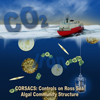
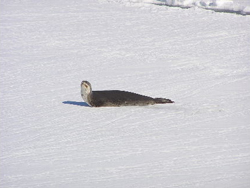
Leopard
Seal on ice (Peter Lee)
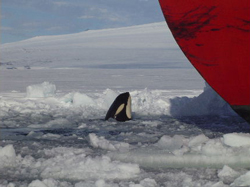
An
orca has a look at the N.B. Palmer (Sasha Tozzi)
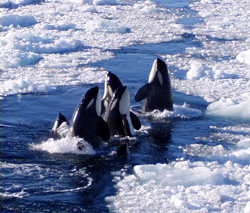
A
group of orcas (Sasha Tozzi)
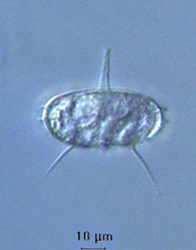
The
dinoflagellate Protoperidinium. Some dinoflagellates can eat algae that are much
larger than themselves by attaching to the larger cell and sucking out its insides.
(Julie Rose)
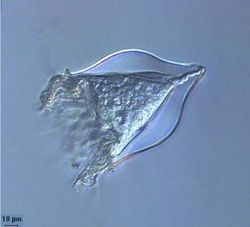
The
ciliate Cymatocylis. Some ciliates and dinoflagellates will eat all of an algal
cell except its chloroplasts, which the grazer then uses to photosynthesize and
get energy for itself. (Julie Rose)
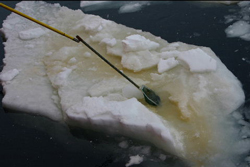
Sampling
algae growing under the sea ice.

Pteropod
Clione antarctica. (Jenny Dreyer)
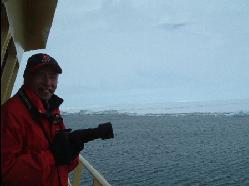
Jack
DiTullio, chief scientist, anonymously nominated as "most amazing organism".
(Anonymous)
| CORSACS: Controls on Ross Sea Algal Community
Structure
2005: A Research Cruise to the Ross Sea to Study What Controls the
Phytoplankton DynamicsQuestions from High Tech
High School of North Bergen, NJ January 17, 2006
Dear Arctic
Exploration ScientistsWe, the biology students of High Tech High School
of North Bergen, NJ, recently had the opportunity to observe the phytoplankton
of the nearby Hackensack river, courtesy of the High Tech High School Riverkeepers. We
were wondering, if you can answer our question: "What is the most interesting
organism you have found on your expidition?" Thank you
Bio
classes and Ms. Lavlinskaia, a teacher ---------------------------------- Dear
Bio classes of High Tech and Ms. Lavlinskaia,
We received your email and thought
your question was wonderful. We are asking various members of the science party
for their opinions on which organisms were the most interesting and will get back
to you shortly (hopefully with pictures too). -Mak Saito ----------------------------- Here
are more answers: Hello - Rob Dunbar again. Even though nearly all
the scientists on this cruise are studying the very small plants that live here
in the Ross Sea, of course we also like the large and obvious animals we encounter.
Everyday we see Weddell seals and Adelie penguins. Most days we see a few Emperor
penguins and Leopard seals and Crabeater seals. We've also seen Minke whales and
a few Orcas (Killer Whales). Out of all the larger marine animals in the Ross
Sea, my favorite is the Southern Bottlenose Whale. While we haven't seen them
on this cruise yet, I have seen them about once every 5 years in the past. They
come into the Ross Sea to feed on fish in summer when the polynya is large. Why
do I like them? Well.....they are extremely rare and almost never observed by
man. They are large beaked whales and are white, like the Beluga whale of the
Arctic. Imagine a porpoise like Flipper. Then imagine it as 40 to 50 feet long
and white and shiny, like snow covered ice. Then imagine 15 of them travelling
together in a tight-knit family unit called a pod. If you want to learn more about
them, try searching on the web...... [NOTE - it was a Bottlenose Whale that
swam up the River Thames this past weekend (1/20-22). Unfortunately, it did not
survive the attempt to bring it back to the open ocean. See the following link
for online coverage: http://news.bbc.co.uk/1/hi/england/london/4635874.stm ] --------------------- Hello
- My name is Walker Smith, and I work at the College of William and Mary
Marine Institute in Williamsburg, VA.I have been working in the Antarctic for
22 years, and work on phytoplankton.Even though I work with microscopic organisms,
my favorite organisms down here are adelie penguins.Penguins occur throughout
the world, even in tropical waters, but they are most common in cooler waters.They
need certain locations in which to form nests, like other birds, as well as access
to the ocean to feed.So the numbers of adelie penguins are limited by both nesting
sites and foraging access. Adelie’s often look pretty silly on the
ice, as they waddle and slide across it to enter the water.Within the water, however,
they are incredibly agile and fantastic swimmers.Being sort of small (each one
weighs about 30 lbs.), they can change direction rapidly and swim very rapidly.To
exit the water, they simply jet out of the water and land on the ice.Landing,
however, can be a bit awkward, to say the least. Adelie’s in the Ross
Sea are really interesting, as they are one of the top members of the food web.They
eat mostly a special type of krill called crystal krill, as well as large amounts
of a small fish called Pleurogamma. They are obligate psychrophiles, meaning they
must have ice in which to exist and thrive. So if the ice were to melt, the Adelie
penguins would disappear. In the Antarctic peninsula, where it is warming very
fast (about 1ºF per decade, on average), Adelie’s are disappearing and
are being replaced by other penguins that do not use the ice.In the Ross Sea,
however, the situation is reversed; Adelie’s are increasing in numbers, perhaps
due to the increasing ice concentrations we find here.There are fossilized penguin
colonies, where scientists find old eggs and nests, and they can be dated accurately.
From them we know the temperatures thousand’s of years ago. One of
the largest penguin colonies in the world is located close to where we study at
a site called Cape Crozier. There are about 100,000 breeding pairs of Adelie penguins
there, and when they are actively feeding in the summer, they deplete their food
resources near the colony.So they have to forage, or gather food, up to 100 kms
(60 miles) from their nests.All of that time they are swimming in the ocean, and
can sometimes fall prey to their two major predators: orcas, or more importantly,
leopard seals.Leopard seals can grab a penguin and shake it when it is in its
teeth, and the carcass of the bird can come straight out of its skin and feathers!No
one said it was an easy life for a penguin. There are so many neat things
about these animals, and I am sure you can think of many questions you can’t
yet answer.For example, why don’t penguin feet freeze when they are on the
ice? How do they stay warm? How do they recognize their mate? How long do the
chicks stay with the parents? Or, how do they taste? [Hint: stick with chicken
tenders] If you can think of questions about penguins, let us know and we can
try to help you figure them out! --------------------- I love working
with algae, but I must admit that my favorite organism in the Antarctic is a little
bigger: the Killer whale (Latin name Orcinus orca). Killer whales were so named
because they were believed to attack human beings. However we now know this not
to be true. Killer whales are not actually whales but are the largest members
of the dolphin family (Family Delphinidae). They have a white abdomen as well
as a white patch behind the eye, and the rest of their body is black. Killer whales
in the Antarctic may have a brownish hue to their white patches because of diatoms.
They also have a very tall dorsal fin, which distinguishes them from other whales.
Male killer whales are larger than females, growing to 9 meters (30 feet) in length,
while females reach only 7 meters (23 feet). Killer whales are carnivores, feeding
on seals, fish, squid, penguins and even whales. In the Antarctic, killer whales
and leopard seals are the top organisms of the food chain. Killer whales can be
found in all of the world’s oceans, but live primarily in colder waters.
They travel in groups called “pods” that can consist of as many as 50
individuals. Most of the individuals are related and usually consist of males
and females, as well as calves and juveniles. Killer whales can remain under water
for up to 17 minutes and dive as deep as 260 meters (853 feet). -Aimee Neeley --------------------- My
favorite organisms in the Antarctic are microscopic, and I’m especially interested
in the kinds of microorganisms that eat algae. Scientists call these types of
organisms algal grazers, since they are feeding on plant-like microbes. My two
favorite groups of algal grazers are ciliates and dinoflagellates. Both of these
groups were named for their type of locomotion. Ciliates move around using structures
called cilia and dinoflagellates are named for the Greek word “dinos”,
which means ‘to whirl’. Dinoflagellates have two flagella, one that
propels them forward and one that causes them to spin as they move. As algal grazers,
these organisms can be really important in the food webs of aquatic ecosystems.
Ciliates and dinoflagellates can also do all kinds of neat things. Some dinoflagellates
can eat algae that are much larger than themselves by attaching to the larger
cell and sucking out its insides. Some ciliates and dinoflagellates will eat all
of an algal cell except its chloroplasts, which the grazer then uses to photosynthesize
and get energy for itself. I have included a picture of Protoperidinium, which
is a dinoflagellate, and Cymatocylis, which is a ciliate. -Julie Rose --------------------- Hey
there avid students of bio! Rob Dunbar here. I am a teacher and researcher at
Stanford University in California. Every summer I hire 3 to 4 high school students
to work in my lab - as science interns - so they can help us learn, and learn
themselves, about the Antarctic seas. My favorite organisms down here are
the ice algae - so named because they live inside the sea ice. These little plants
actually live in tiny channels filled with brine, within the solid sea ice. Sometimes
these brines are really salty - up to 3 times the saltiness of the ocean. And
these brines can be cold, as much as 10 to 20 degrees below zero centigrade. Yet
these little plants do just fine, and keep on growing, fixing carbon as long as
there is sunlight penetrating into the ice. In some areas of Antarctica, these
little ice algae are the base of the food chain. When you think that each year,
as you go from summer to winter to summer again the amount of sea ice that forms
and then melts is as large as all of North America, you can start to appreciate
how important these little guys must be....... Cheers,
Rob -------------------------- There
are many interesting phytoplankton organisms in Antarctica but I have also been
looking at what we find in zooplankton tows and they are equally interesting and
an important part of the Antarctic foodweb. One of my favorite organisms is the
pteropod, which is a mollusc. These animals are called sea butterflies because
they appear to fly through the water with appendages like wings. There are two
species we are finding here in the Ross Sea; Limacina helicina antarctica and
Clione antarctica. L. antarctica feeds on the phytoplankton has a shell similar
to a snail, and is black in color. In contrast, C. antarctica feeds on the Limacina,
does not have a shell, and is bright pink in color. Their graceful movements in
the water make them spectacular to watch as their wings move up and down. I never
grow tired of watching them and they are pretty amazing creatures. -Jenny
Dreyer
-------------------------- BACK |

